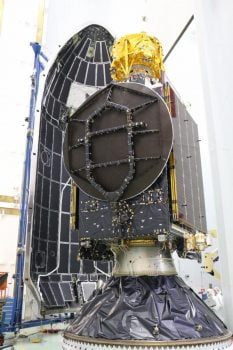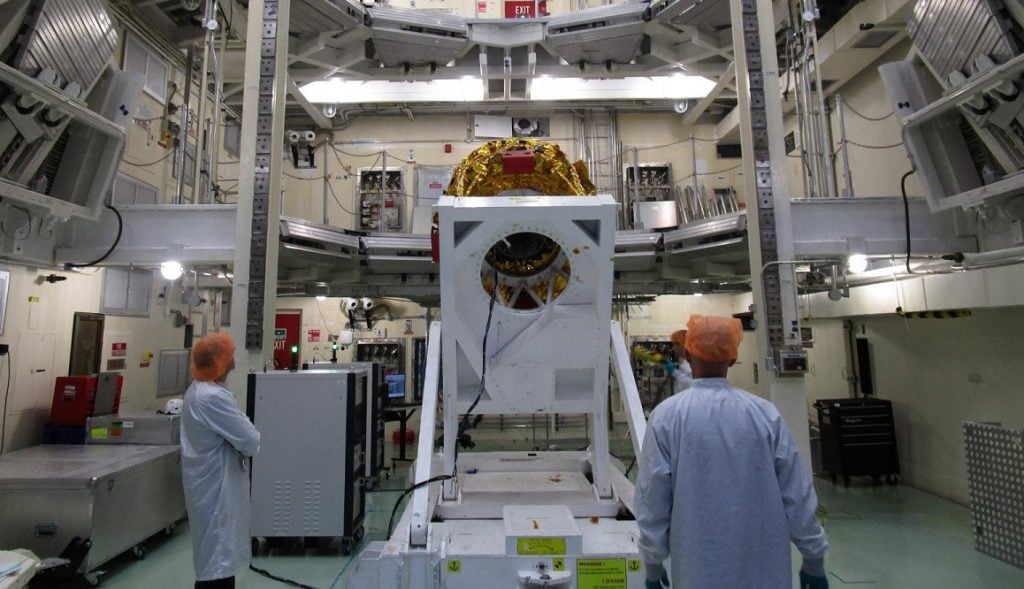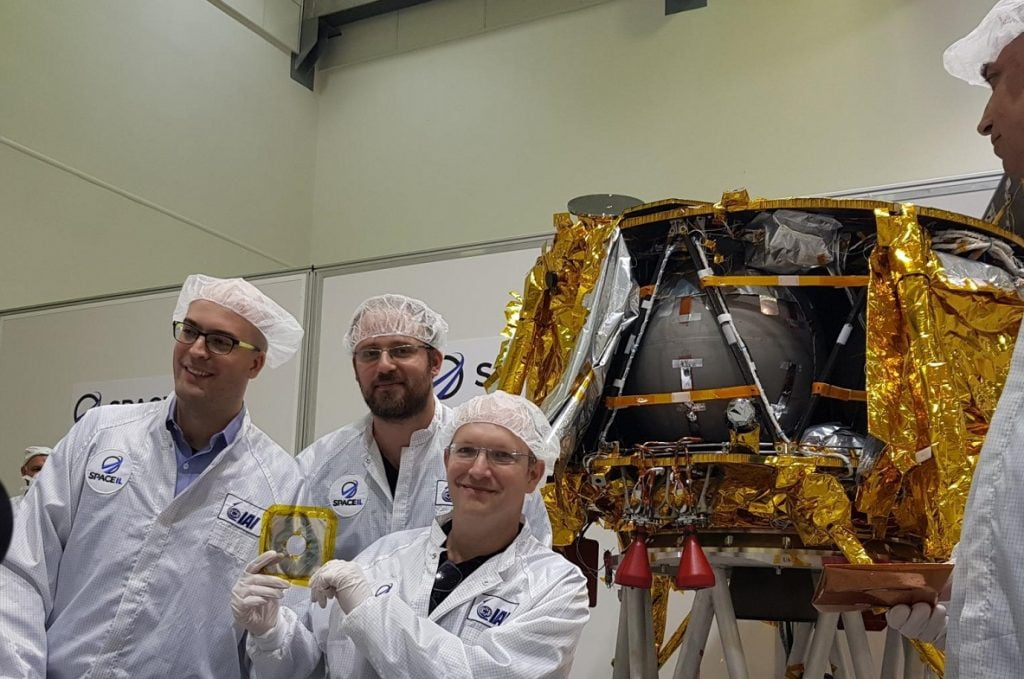UPDATE: Beresheet was launched successfully from Cape Canaveral, Florida on Friday, February 22, 2019 at 3:45 am Israel time and the initial data from the spacecraft was received at 4:23 am. To track the spacecraft’s journey to the moon, see here.
Prime Minister Benjamin Netanyahu congratulated everyone involved in the project, saying “the real fuel of this spacecraft is the Israeli audacity and the Israeli genius.
“This is a great step for Israel and a huge step for Israeli technology,” he added.
The launch of Israel’s first voyage to the moon is upon us and giddiness over the possibilities of what a successful landing will mean for Israel – and the international space community – are growing by the minute.
Excitement abounds in Israel and on social media networks with people posting photos of themselves in a SpaceIL picture frame, sharing the hashtag #israeltothemoon, posing for selfies at a replica of the spacecraft in the Habima Square in Tel Aviv. The Tel Aviv Municipality lit up its city hall with lights reading, Tomorrow Israel Is Going To The Moon.
If all goes according to plan, the lunar lander Beresheet, whose name in Hebrew means “In the Beginning/Genesis,” will blast off aboard a SpaceX Falcon 9 from Launch Complex 40 at Cape Canaveral Air Force Station at 3:45 am Israel time on Friday.
SEE ALSO: Chutzpah, Dreams And Ingenuity Behind Israel’s First Moonshot
Anticipation is high because if Beresheet completes its lunar mission on April 11, Israel will join superpowers China, Russia, and the United States in landing a spacecraft on the moon.
Little Israel. With the smallest spacecraft ever to be sent to the moon.
And that’s not the only amazing statistic. Beresheet is remarkable because almost everything about the unmanned spacecraft goes against convention.
 It began as a dream by three young engineers and not a government program, making it the first privately funded space probe to shoot for the moon. It cost just $100 million to plan and develop, whereas other space missions in the past have run in the billions of dollars.
It began as a dream by three young engineers and not a government program, making it the first privately funded space probe to shoot for the moon. It cost just $100 million to plan and develop, whereas other space missions in the past have run in the billions of dollars.
But as Israel has shown time and again, when it comes to technological prowess, size doesn’t matter.
Indeed, this small spacecraft has big hopes riding on it.
“It was very difficult to raise money for this mission because it was really a mission impossible,” said South African-Israeli philanthropist Morris Kahn, the president of SpaceIL. “I didn’t realize it was impossible and the three engineers who started this project didn’t realize it was impossible, and the way we in Israel think, nothing is impossible. We dare to dream. And we really are making this dream come true.”
From a physical design point of view, Beresheet has been likened to a gold-colored robotic spider. It is roughly the size of a washing machine, reaching a height of 1.5 meters, about two meters in width, and weighing just 600 kilograms.
The design of the craft changed twice since its first inception in 2011 until the final touches were made last year.
The SpaceIL spacecraft was originally designed to meet regulations set out by the now-defunct Google Lunar X Prize competition, an international contest that challenged the world’s engineers to create and send the first private lander to the Moon. The SpaceIL crew chose to continue with the mission – with or without the prize money – and kept dimensions of their lunar lander to a minimum and with as low redundancy as possible.
A multi-disciplinary team of some 250 engineers, scientists, and computer scientists from the non-profit SpaceIL and state-owned Israel Aerospace Industries (IAI) designed, engineered and developed Beresheet. The actual building of the spacecraft from full-scale development took just four years.
“The navigation control system and the simulator were developed from scratch and they are very sophisticated,” Opher Doron, IAI’s Space Division General Manager, told a prelaunch press conference in Ramat Gan.
Sign up for our free weekly newsletter
SubscribeDoron tells NoCamels that the “main computer and computer chips, as well as other pieces of technology and the cameras, are Israeli-made.”
One of the main issues facing the SpaceIL and IAI team was how to land the spacecraft on the Moon without it breaking apart. So, they created four foldable landing legs with energy absorption mechanisms to ensure a soft landing.
“The structure is Israeli, the landing legs are Israeli, the main computer is Israeli, the design of the spacecraft is Israeli… most of the technologies onboard and the engineering is Israeli. It is an Israeli mission,” says Ido Anteby, CEO of the SpaceIL. “Of course, there are some parts of the sub-systems that come from vendors around the world. But almost all the technology onboard is Israeli.”
Indeed, Beresheet truly shows off Israel’s prominent technological and engineering innovation and expertise. It highlights the country’s aptitude in creative thinking, resourcefulness, and advance research.
“It was very exciting to work with SpaceIL on this project and also interesting from an engineering point of view. This was an inspiration,” Inbal Kreiss, Deputy General Manager, Space Division, IAI, tells NoCamels.
“It used to be that only superpowers had the ability to go and do things like land on the Moon, but lately there’s been so much flourishing of technology, which has been enhanced greatly by the computer revolution,” Phil Metzger, a planetary physicist at the University of Central Florida, told The Verge. “Now it’s within the range where small groups of people can build a lunar lander, which is super amazing.”
Israel’s tech expertise in space sciences is already world-renowned. The country is known for developing and manufacturing advanced technology solutions for satellites, unmanned and robotic systems, radars and more.
There is an Israeli-developed space-qualified CMOS (complementary metal–oxide–semiconductor) sensor aboard the Parker Solar Probe.
The country is a mecca for satellite development.
“Israel is blessed with human capital and brain power. We can create effective solutions that afterward become global standards. We want to change the game of satellites as flash drives did to floppy discs,” Raz Itzhaki Tamir, co-founder & CEO of NSL Comm and an expert on nano space technology, tells NoCamels.
Even NASA has taken interest in this little spacecraft. The space agency is allowing the Israeli team to use its Deep Space Network to communicate with Beresheet in deep space.
The spacecraft is built to withstand extreme environmental conditions during launch, in space, during landing and for its lunar stay. Yet, IAI and SpaceIL engineers noted at the prelaunch press conference that once on the moon, the spacecraft will only function for about two Earth days. In that time, Beresheet will take a selfie, gather imagery of the Moon, and transmit information back to the mission control room in IAI’s space facility in Yehud.
SpaceIL engineers hope the spacecraft will land in an area on the Moon known as Mare Serenitatis because this region is supposed to have some “magnetic anomalies” that the Israeli team hopes to analyze using an onboard magnetometer. SpaceIL is conducting a scientific experiment together with the Weizmann Institute of Science to take measurements of the Moon’s mysterious magnetic field.
On board, there’s also a time capsule and a nano-Bible microscopically etched on a small metal disc the size of a coin.
Landing a spacecraft on the moon will bring an extraordinary achievement in engineering and the country’s technological capabilities. SpaceIL hopes it will advance and promote science and research.
“It’s exciting,” says Doron. “It’s a great technological achievement.”
SpaceX will broadcast the historic launch live on its YouTube channel, and SpaceIL will simultaneously air on Facebook live video from inside the control room in Yehud.
Viva Sarah Press is a journalist and speaker. She writes and talks about the creativity and innovation taking place in Israel and beyond. www.vivaspress.com
Related posts

Editors’ & Readers’ Choice: 10 Favorite NoCamels Articles

Forward Facing: What Does The Future Hold For Israeli High-Tech?

Impact Innovation: Israeli Startups That Could Shape Our Future






Facebook comments